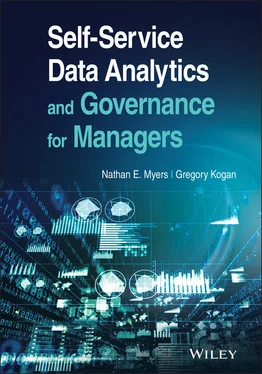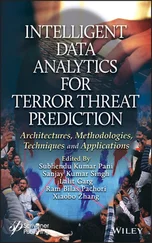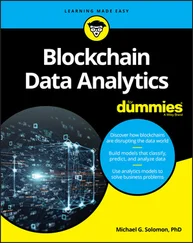The rise of data analytics is transforming business functions in an accelerated pace. This transformation is driven by managements' strategic goal of evolving their organizations to being data-driven, interconnected, and innovative in their approach to unlocking insights from the rapidly increasing volume of data. While data analytics is an extremely broad category of technologies and disciplines, self-service analytics has recently emerged as a significant driver of accelerated digital transformation. At the heart of digital transformation in accounting, finance, and operations functions is the move from manual spreadsheet-based data processing to structured, robust, and efficient automated processing using self-service analytics tools. Business professionals who spend their days assembling and enriching information from disparate sources in spreadsheets, performing routine formulaic processing steps, comparisons, and aggregations, now have data analytics tools at their disposal to rapidly automate the least value-added portions of their roles.
Even though automation techniques through core IT systems have existed for decades, the defining features of the new wave of self-service analytics automation is that it is “small.” Small automation is relatively inexpensive from a capital investment perspective compared to multi-million-dollar enterprise IT investments. Self-service data analytics offers flexible, no-code, low-cost processing capabilities that are directly accessible to process owners outside of IT. Without the need to involve IT or to await the technology investment cycle, self-service data analytics solutions can be developed and implemented in only hours or days – directly by those overseeing the process. Such capabilities allow for dramatic acceleration of routine processes and reduce the likelihood that manual processing errors are introduced. Perhaps most importantly, they transform the role of business professionals who can reclaim time to focus on higher-order data analysis, the implementation of improved controls, or on other emerging business priorities. These benefits taken together amount to a quantum leap forward for organizations intent on truly harnessing data capabilities and optimally deploying human capital.
While self-service data analytics deployments can improve process control and efficiency in the finance function, they also markedly impact the internal control environment. In the past, the control environment which safeguarded the enterprise from IT general and application risks was centralized around the core technology stack. As processing capabilities are now placed directly into the hands of end-users to import and analyze data, structure processing steps, and export outputs, the risk environment has been dramatically shifted. Robust internal control governance built around systems over several decades has been side-stepped by increased data analytics processing outside of systems, necessitating a commensurate shift in governance. We will systematically inventory the body of existing regulatory guidance, legacy IT governance precepts, and data governance and model governance frameworks to identify foundational principles which must be extended to forge a data analytics governance framework. Building upon existing governance literature, we will outline the first comprehensive, fit-for-purpose, and actionable data analytics governance framework for managing the governance triad: project governance, risk governance, and investment governance.
Three governance disciplines are required to sustainably scale self-service data analytics: project governance, risk governance, and investment governance. Project governance provides a framework to ensure that efforts have the right stakeholder support and that solutions satisfy requirements and are tested to a high standard. Importantly, project governance also mandates the maintenance of an adequate audit trail to enable process assurance capabilities. Risk governance is a framework for the assessment and management of risks introduced by individual builds – and the portfolio, as a whole. Automation builds can be assessed according to unique risk scoring dimensions, allowing the risks introduced to be recognized and well understood. Armed with full transparency, the organization can actively prioritize risk response strategies for higher risk analytics builds in the portfolio. Investment governance is a framework providing for detailed cost and benefit analysis, weighing the expected efficiencies of analytics deployments against the cost and effort required – such that firm resources and investment dollars flow logically to the best opportunities. Investment governance ensures that projects selected for implementation provide adequate return on investment (ROI).
It is not enough to theoretically discuss the application of data analytics in accounting, finance, and operations. We will discuss common use cases and take readers through our approach to process discovery to uncover opportunities to employ analytics for control and efficiency. We will demonstrate the application of one prominent data analytics tool, Alteryx, to common use cases through our practical case studies. To build familiarity with the features and functionality on offer, we will demonstrate the application of data analytics to real problems that managers are likely to face, and we will introduce them in an extremely approachable way for the consumption of a broad audience with varied levels of data analytics exposure. We will suggest ways to industrialize the data analytics function to achieve the scale required to optimize expected program benefits. The use of self-service data analytics in accounting, finance, and operations functions is relatively new and rising to prominence. A comprehensive governance framework entirely suited for self-service data analytics programs has not yet been established. Accordingly, in this book, we will draw from more mature and established frameworks (data governance, system governance, and model governance) to build a foundational governance model that can grow with your footprint, as your organization embarks on its inevitable digital journey.
Throughout the development of this book, we were privileged to have sincere and valuable advice from contributors, reviewers, and peers in the data analytics for finance and accounting research and teaching area, as well as industry change practitioners at leading organizations. These individuals provided us with invaluable perspective, recommendations, feedback, and constructive review.
| Sean Adams |
Dan Palmon Rutgers University |
| Douglas Boyle University of Scranton |
Ray Pullaro Long Island University |
| Kevin Dow University of Auckland |
Vernon Richardson University of Arkansas |
| Daniel Gaydon University of Scranton |
Edward Rogoff Long Island University |
| David Greene Indiana University |
Marcia Watson Trinity University |
| Dana Niblack |
|
Nathan E. Myers, MBA, CPA, Six Sigma Black Belt, has over 20 years of public accounting and investment banking experience at flagship organizations including Ernst & Young, Morgan Stanley, UBS Investment Bank, Credit Suisse, and JP Morgan. He received both his bachelor's degree in Accounting and an MBA in Accounting from the Indiana University, Kelley School of Business. Much of his career has been spent in finance functions as a controller and as a change manager for products such as FX spot, forwards, and options, securities lending, margin, and equity finance at global investment banks, building scalable controls and delivering strategic technology change. In the recent past, his career has evolved from owning a portfolio of large-scale technology change, to putting data analytics tooling into the hands of users to drive aggressive digital transformation. Nathan has worked to build rigid data quality standards to drive rich and accurate datasets as inputs to processing, has managed robotic process automation (RPA) portfolios, and has scaled end-user data analytics across organizations to capture control and efficiency benefits. He has seen firsthand the requirement to build and maintain close governance over these toolsets, as they rapidly proliferate across banks and large organizations. He resides on Long Island, New York, with his wife, son, and daughter.
Читать дальше












